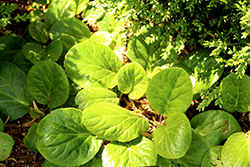It's all about ...
plants

Height: 10 inches
Spacing: 18 inches
Sunlight:
![]()
![]()
Hardiness Zone: 6a
Other Names: Hairy Leaf Bergenia, Winter Begonia, Pigsqueak
Description:
A very nice form of Bergenia with large glossy green leaves that bronze in fall and winter; clusters of pale pink flowers with rose pink calyces open on short thick stems in early to mid-spring; best with consistent moisture and brief or dappled sunlight
Ornamental Features
Fringed Bergenia features unusual spikes of shell pink flowers with rose calyces rising above the foliage from early to mid spring. Its attractive large glossy round leaves are green in colour with distinctive chartreuse veins. As an added bonus, the foliage turns a gorgeous coppery-bronze in the fall.
Landscape Attributes
Fringed Bergenia is an herbaceous perennial with a ground-hugging habit of growth. Its relatively coarse texture can be used to stand it apart from other garden plants with finer foliage.
This is a relatively low maintenance plant, and is best cleaned up in early spring before it resumes active growth for the season. Deer don't particularly care for this plant and will usually leave it alone in favor of tastier treats. It has no significant negative characteristics.
Fringed Bergenia is recommended for the following landscape applications;
- Mass Planting
- Border Edging
- General Garden Use
- Groundcover
- Naturalizing And Woodland Gardens
Planting & Growing
Fringed Bergenia will grow to be about 8 inches tall at maturity, with a spread of 24 inches. When grown in masses or used as a bedding plant, individual plants should be spaced approximately 18 inches apart. Its foliage tends to remain low and dense right to the ground. It grows at a slow rate, and under ideal conditions can be expected to live for approximately 10 years. As an herbaceous perennial, this plant will usually die back to the crown each winter, and will regrow from the base each spring. Be careful not to disturb the crown in late winter when it may not be readily seen!
This plant does best in partial shade to shade. It prefers to grow in average to moist conditions, and shouldn't be allowed to dry out. It is not particular as to soil pH, but grows best in rich soils. It is somewhat tolerant of urban pollution. Consider covering it with a thick layer of mulch in winter to protect it in exposed locations or colder microclimates. This species is not originally from North America. It can be propagated by division.
This plant is not reliably hardy in our region, and certain restrictions may apply; contact the store for more information.
